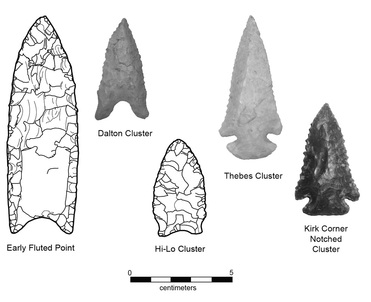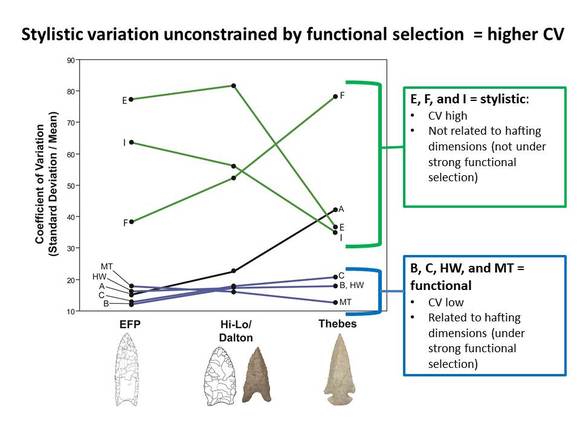Functional and Stylistic Variability in Paleoindian and Early Archaic Projectile Points from Midcontinental North America (2013, North American Archaeologist 34(1):71-108)
|
This paper presents a portion of the archaeological data and analysis that was part of my dissertation. Basically, it examines some simple metric data from 1771 Early Paleoindian (Clovis/Gainey), Late Paleoindian (Dalton/Hi-Lo) and Early Archaic (Kirk and Thebes) points from the Midcontinent (defined as Illinois, Indiana, Kentucky, Michigan, and Ohio).
There is a lot of size/shape variability among these kinds of points:
There have been several recent published studies that use morphometric data from projectile points (Early Paleoindian points in particular) to make interpretations about early hunter-gatherers in eastern North America. In my opinion, a weak point of many of those studies is that they glom together all the size/shape variability in these tools without really considering what part of the variability is "functional" and what part is "stylistic." Note that I put those words in quotation marks: I am aware that these concepts are somewhat problematic. I don't think it is possible to discriminate all aspects of "functional" and "stylistic" variability in these artifacts. But I do think it is important to acknowledge that some aspects of the size and shape of a tool are more constrained by functional considerations (i.e., what the tool is designed to do) than are others. And I think it is important to try to figure out what those aspects of variability are before you throw it all into the mix and make interpretations about social organization, regional adaptations, or migration patterns. What does the variability actually mean? What aspects of variability are most constrained by "function" and which are most free to vary "stylistically"? Good question.
I found that, consistent with what one would predict based on the role of these tools as parts of compound projectile weapons, metric attributes that are related to the width and thickness of the haft region (blue box in the figure above) are less variable than those that are not (green box in the figure above). The mixture of variables most closely related to hafting shifts during the transition from lanceolate to notched points.
This analysis provided a basis for selecting several "stylistic" variables that could be analyzed with respect to space in my dissertation. The paper is available here. Data from the paper are available here. |

